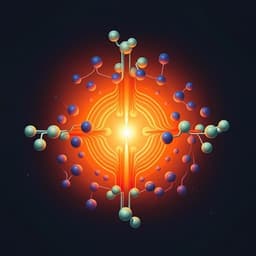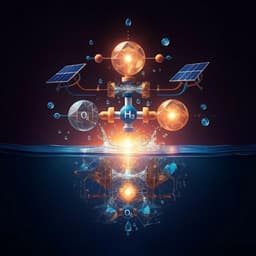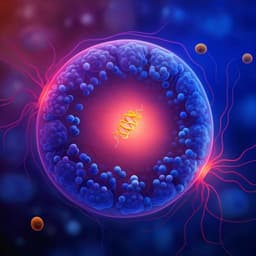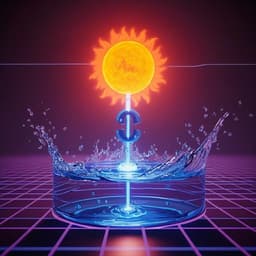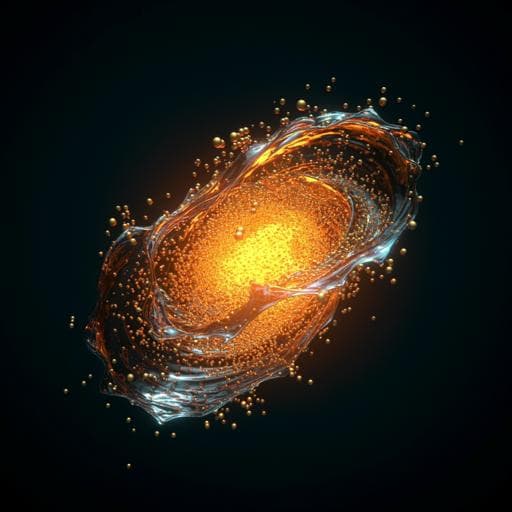
Engineering and Technology
New solar energy-storage resource of plasmon-activated water solution with higher chemical potential
C. Yang, S. Yu, et al.
Discover an innovative approach to solar energy storage through plasmon-activated water (PAW)! This research by Chih-Ping Yang, Shih-Hao Yu, Fu-Der Mai, Tai-Chih Kuo, and Yu-Chuan Liu reveals how PAW, enhanced by sunlight on gold nanoparticles, surpasses traditional methods with a chemical potential that boosts evaporation and vital chemical reactions, all while maintaining its properties for two days.
~3 min • Beginner • English
Introduction
The study addresses how to convert and store solar energy in a simple, low-cost aqueous medium by altering water’s hydrogen-bond (HB) network via plasmon-induced hot electron transfer (HET) from Au nanoparticles (AuNPs). Water’s physicochemical properties are governed by a dynamic HB network that can be perturbed at interfaces or under confinement, potentially increasing activity. Prior work has used AuNP plasmonics for catalysis and reported transient HET effects, but without energy storage. The authors hypothesize that sunlight-excited AuNPs can inject hot electrons that transiently intercept breaking HBs, yielding a metastable plasmon-activated water (PAW) with reduced HBs, higher chemical potential, and measurable lifetime. They aim to demonstrate PAW formation under natural sunlight, quantify its storage lifetime and conversion efficiency, and show enhanced physical (evaporation, heat capacity/boiling point) and electrochemical (OER, HER) performance relative to DI water. Two preparation routes (in situ and ex situ addition of electrolyte) are compared to elucidate the role of dissolution energetics on the stored chemical potential.
Literature Review
Background includes: interfacial and confined water exhibits disrupted tetrahedral HB networks and altered properties (e.g., ~50% broken HBs at Au interfaces); AuNPs with localized surface plasmon resonance (LSPR) are widely used for SERS, photothermal therapy, and photocatalysis via HET; prior energy storage materials (e.g., phase-change composites, solar-charged pseudocapacitors) require complex fabrication; earlier work showed PAW generation with green LEDs via HET on AuNPs, indicating reduced HBs and altered thermophysical properties. Literature on improving OER/HER mostly focuses on catalysts, with limited attention to modifying the structure/activity of the water reactant itself. This study builds on these to propose PAW as a solar-energy-derived, metastable, higher-chemical-potential solvent enhancing reactions without new catalysts.
Methodology
- AuNP-coated ceramics: Twenty ceramic rods were soaked in 200 mL of ~10 nm AuNP suspension (50 ppm) for 1 day in the dark; ~7.3×10⁻⁶ g AuNPs adsorbed per rod. Rods were rinsed and dried at 120 °C for 1 day, then rinsed to pH ~7.15 at 24 °C.
- PAW preparation under sunshine: Eighteen AuNP-coated rods were placed in sealed 500 mL glass vials containing 250 mL aqueous solution and irradiated by natural sunlight for 3 h around noon.
• In situ PAW: 0.1 M KCl added before irradiation to DI water. After irradiation, pH changed 7.15→7.21; temperature 24→35 °C; cooled to room temperature prior to tests.
• Ex situ PAW: Irradiate DI water first, then add KCl to 0.1 M immediately post-irradiation; cool to room temperature.
• Blank controls: ceramic rods without AuNPs under identical conditions; additional open-bottle irradiations to assess evaporation.
• ICP-MS assessed dissolved metals (ppb level; slight Au increase post-irradiation attributed to HET-related dissolution).
- Physical characterizations:
• Evaporation: 0.1 M KCl solutions tested on an orbital shaker for 30 min in ambient air; also time-resolved open-bottle sunshine tests (1–3 h) for PAW vs blank.
• Boiling point and specific heat proxy: solutions heated at constant power; temperature vs time recorded from room temperature to 40 °C (linear regime) and to near boiling; slopes inversely proportional to specific heat (normalized to DI = 1) for fresh and 2-day-aged samples.
• Zeta potential (electrolyte-free water) measured at 0 and 2 days; hydroxyl radical intensity by ESR compared to DI.
• NMR relaxation: diffusion-averaged T1 (spin-lattice) for 0.1 M KCl solutions, fresh and 2-day-aged, to probe HB strength.
- Electrochemistry:
• OER and HER by linear sweep voltammetry (LSV) on planar Pt electrodes in 0.1 M KCl (neutral) and 0.1 M NaOH (alkaline); vertices at 1.5 V (OER) and −1.4 V (HER); performance tracked over 0–3 days.
• Au oxidation-reduction cycle (ORC) on planar Au electrodes: cyclic voltammetry (CV) at 0.5 V s⁻¹ to roughen Au, following anodic dissolution and cathodic redeposition; compare DI, PAW in situ, PAW ex situ for 5th and 25th scans, fresh and 2-day-aged. Additional tests under fluorescent lamp illumination vs dark in DI water (0.1 M KCl) to demonstrate light-enhanced HET effects on AuNPs formed in situ on roughened Au.
• Ferricyanide probe: CV of 50 mM K3Fe(CN)6 to determine diffusion coefficients (Randles–Sevcik) and electron transfer rate constants k (per Nicholson/Ferri analysis), in fresh and 2-day-aged solutions.
- Energy-conversion efficiency estimation: η = (E_HB·M_water + m·s·ΔT)/(P_sunshine·t)×100%, using E_HB = 20 kJ mol⁻¹, DNHBW difference between DI and PAW (from prior work), 250 g solution, s = 0.0042 kJ g⁻¹ °C⁻¹, ΔT measured, bottle area ≈0.035 m², solar irradiance 1 kW m⁻², t = 1–3 h; also report efficiencies excluding sensible heat.
Key Findings
- PAW formation and lifetime: PAW generated under natural sunlight via AuNP HET exhibited elevated activity for at least 2 days at room temperature, decaying over time.
- Evaporation (0.1 M KCl, 30 min, shaker):
• Fresh: DI 12.73±0.25 mg; PAW in situ 14.03±1.01 mg (+10.2%); PAW ex situ 13.77±1.27 mg (+8.2%); blank 12.97±0.76 mg (+1.9%).
• Aged 2 days: DI 11.07±0.12 mg; in situ 12.27±0.74 mg (+10.8%); ex situ 11.63±1.72 mg (+5.1%); blank 10.90±0.87 mg.
• Open-bottle sunshine: in situ evaporation rate > blank by 17.5%, 15.3%, 9.8% in 1st–3rd hours, confirming photochemical origin.
- Zeta potential and radicals (electrolyte-free water): PAW ζ = −29.6±0.56 mV (0 d) and −26.9±0.73 mV (2 d); DI ζ = −1.63±0.41 mV (0 d) and −1.58±0.29 mV (2 d). Hydroxyl radical signals decreased in PAW by 45±3.9% (fresh) and 29±3.3% (2 days) vs DI.
- Boiling point and specific heat proxy:
• Boiling points (fresh, 0.1 M KCl): DI 97.4±0.2 °C; PAW in situ 96.6±0.1 °C; PAW ex situ 96.4±0.2 °C; blank 97.8 °C.
• Normalized specific heat (25–40 °C): fresh in situ 0.832, ex situ 0.889 (vs DI = 1); blank ~0.963 (−3.7%). After 2 days: in situ 0.909, ex situ 0.929.
- NMR T1 (s, 0.1 M KCl):
• Fresh: DI 3.230±0.055; in situ 3.315±0.004; ex situ 3.281±0.041.
• 2 days: DI 3.139±0.022; in situ 3.290±0.032; ex situ 3.240±0.004. Longer T1 indicates weaker HBs in PAW.
- OER (Pt, 0.1 M KCl, 1.5 V): fresh currents: DI 0.331±0.005 mA; in situ 1.060±0.165 mA (+~220%); ex situ 0.479±0.033 mA (+~40%). After aging: in situ still +64% (1 d) and +22% (2 d); ex situ slight improvement after 1 d; blank +~9.2% vs DI (as-prepared).
- OER (Pt, 0.1 M NaOH, 1.5 V): fresh currents: DI 2.0386±0.1708 mA; in situ 2.5400±0.1949 mA (+25%); ex situ 2.2830±0.2621 mA (+12%). After 3 days: in situ +14%; ex situ +3.8% vs DI.
- HER (Pt, 0.1 M KCl, −1.4 V): fresh currents: DI −0.0367±0.0015 mA; in situ −0.0793±0.0006 mA (+120%); ex situ −0.0494±0.0013 mA (+35%). In situ retained higher efficiency: +60% (1 d), +50% (2 d), +28% (3 d).
- Au ORC (Au electrode, 0.1 M KCl): cathodic redeposition peak currents increased vs DI: fresh 5th scan in situ +13%, ex situ +9.7%; 25th scan in situ +13%, ex situ +5.4%. After 2 days, increases smaller (~2.2%), consistent with decay of PAW activity.
- Ferricyanide probe (50 mM K3Fe(CN)6): diffusion coefficients D:
• Fresh: DI 2.00±0.01×10⁻⁶ cm² s⁻¹; in situ 2.34±0.01×10⁻⁶ (+17%); ex situ 2.27±0.01×10⁻⁶ (+14%).
• 2 days: DI 1.86±0.03×10⁻⁶; in situ 2.32±0.06×10⁻⁶ (+25%); ex situ 1.99±0.04×10⁻⁶ (+7%).
Electron transfer rate constants k:
• Fresh: DI 0.218±0.014 s⁻¹; in situ 0.233±0.014 (+6.9%); ex situ 0.226±0.015 (+3.7%).
• 2 days: DI 0.217±0.005; in situ 0.257±0.008 (+18%); ex situ 0.233±0.005 (+7.4%).
- Light effect on ORC in DI (fluorescent lamps): cathodic peak increases vs dark: 5th scan full illumination +10%, shadow +6.9%; 25th scan full +14.1%, shadow +7.6%.
- Energy-conversion efficiency of PAW preparation under sunshine: ~6.7% including sensible heat (3.7% excluding); for 1 h and 2 h irradiations: ~8.1% and 7.7% (including), and ~4.5% and 4.2% (excluding sensible heat).
Discussion
Results support the hypothesis that plasmon-induced HET from sunlight-excited AuNPs can transiently intercept breaking hydrogen bonds in water, forming a metastable PAW with reduced HB strength, smaller water clusters, increased diffusion, and higher chemical potential at room temperature. This manifests as faster evaporation, lower boiling point, reduced apparent specific heat, longer NMR T1, and suppressed hydroxyl radical signatures. Electrochemically, PAW lowers onset potentials and boosts OER/HER currents in both neutral and alkaline media, attributable to enhanced mass transport (higher D) and interfacial kinetics (higher k), not to catalyst changes. The in situ electrolyte condition preserves more stored energy than ex situ, as ex situ salt dissolution consumes part of the PAW’s chemical potential and reforms HBs, diminishing performance. Activity decays over days as HBs re-form, but measurable enhancements persist up to 2–3 days, enabling practical short-term energy storage. Illumination-dependent increases in Au ORC currents even in DI water corroborate HET’s role. Overall, PAW functions as an energy-rich solvent generated directly from sunlight, enabling improved water-involved reactions without new catalysts.
Conclusion
The study demonstrates a simple, low-cost solar energy-storage concept: generating plasmon-activated water (PAW) via sunlight-driven hot electron transfer on Au nanoparticles. PAW exhibits higher chemical potential and reduced hydrogen bonding, persisting for about two days at room temperature. Compared to DI water, PAW shows faster evaporation, lower boiling point, reduced apparent specific heat, longer NMR T1, and significant enhancements in OER and HER (up to ~220% and ~120% in neutral media, respectively). Mass transport and electron transfer of redox probes are also improved. An overall solar-to-PAW energy conversion efficiency of ~6.7% (3.7% excluding sensible heat) is achieved, comparable to more complex systems. The in situ electrolyte approach outperforms ex situ due to avoiding energy consumption by salt dissolution. Future work should focus on strategies to prolong PAW’s lifetime, understand microscopic mechanisms of HB disruption and relaxation, optimize nanoparticle/irradiation parameters, and explore applications in green energy (water splitting, oxygen reduction/H2O2 generation) and water processing (e.g., desalination via enhanced evaporation).
Limitations
- The enhanced activity of PAW decays over time (notably within 2–3 days) as hydrogen bonds re-form, limiting storage duration.
- Ex situ electrolyte addition consumes stored energy via dissolution, reducing the PAW effect compared to in situ preparation.
- Experiments primarily used KCl (and NaOH for alkaline OER); broader electrolyte matrices and ionic strengths were not extensively explored here.
- Energy-conversion efficiency estimates rely on assumptions (HB energy per mole, DNHBW differences, irradiance, vessel area) and provide approximate values.
- The mechanism is inferred from macroscopic and spectroscopic proxies (e.g., T1, evaporation, D, k); direct real-time structural probes of HB dynamics under sunlight would strengthen causal attribution.
Related Publications
Explore these studies to deepen your understanding of the subject.



